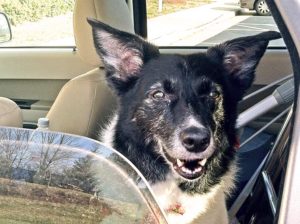Editor’s Note: This new sponsored column on pet safety is written by Terry Haas, a pet care professional. Terry owns Loyalty Pet Care and its Safety Furst division.
 Recently, a dog owner in Virginia left a store only to discover police and rescue personnel surrounding her car. The two dogs she had left in the car, parked in the shade with the windows cracked for about an hour, had died. In spite of her insistence that she had just “made a mistake — a huge mistake,” the dog owner was charged with two felony counts of animal cruelty.
Recently, a dog owner in Virginia left a store only to discover police and rescue personnel surrounding her car. The two dogs she had left in the car, parked in the shade with the windows cracked for about an hour, had died. In spite of her insistence that she had just “made a mistake — a huge mistake,” the dog owner was charged with two felony counts of animal cruelty.
She didn’t know her actions would cause her dogs harm, and unfortunately for many dogs, she’s not alone. According to Alice Burton, Chief of Animal Control Animal Welfare League of Arlington, it happens more often than you might think.
“We have 62 cases in our system where our Animal Control Officers responded to a call of a dog trapped in a hot car,” Burton said. “However, the number of times it is reported is higher (probably 80) because if the dog is not in distress (panting, barking) we do not respond, but will monitor the situation. Owners that leave their pet in the vehicle could be charged with Cruelty to Animals which is a Class 1 misdemeanor.”
On a warm, sunny or even an overcast day, the average normal-muzzle dog left to wait in a parked vehicle will be in respiratory distress in 10 minutes and dead in 20. A dog with a shorter muzzle (such as a Pug or Boston Terrier) will expire in even less time.
We all want to consider our dogs part of the family. We want to take them everywhere. But dogs differ from humans in ways that, if we aren’t careful, can result in tragic accidents.
Humans and some animals (horses, for example) sweat to cool themselves. Our type of sweating allows us to expend energy over long periods while maintaining safe body function. We have endurance. We can also acclimate to warming temperatures.
Although dogs have sweat glands, too, they’re not designed for cooling. Dogs cool themselves by panting, which cools the mouth and tongue as well as the blood flowing through the head, an obviously inefficient process. They also get some extra support by finding good places to rest. They find cool surfaces to press against the thinly furred areas of their bodies.
Watch your dog when it’s hot. Outdoors, he’ll select a shady spot, maybe dig up some cool earth beneath the surface, and lie in that spot. Indoors, he’ll flop onto a cool tile floor.
A parked car collects sunlight like a solar cell. The temperature in the car rises rapidly, turning the interior into an oven. Dogs can’t say “let me out,” and we often misinterpret their body language and limitations. There is no cool earth or tile floor in a car, and the dog can’t open the door to go look for a cooler spot. As animal guardians, we need to educate ourselves on how to prevent these dangerous situations. Laws like Virginia’s are designed to help speed the education process along.
What might surprise you is that it doesn’t have to be a hot summer day to be deadly to take your dog along while you run errands. When it’s just 70 degrees outdoors, the interior of your car becomes dangerous. To help remember this, think of the “Canine Car Cutoff” — 40/70.
- When it’s 40 degrees Fahrenheit or below outside, your dog DOES NOT ride along with you.
- When it’s 70 degrees Fahrenheit or above outside, your dog DOES NOT ride along with you.
- When it’s between 40 and 70 degrees Fahrenheit, it’s OKAY to take your dog on a ride-along where he might be unattended in your parked vehicle with access to water for short periods.
Pledge to keep the Canine Car Cutoff this year! The Canine Car Cutoff is 40/70!
And if you do see a dog potentially at risk in a parked vehicle, you are asked to report the incident by calling the Arlington County Animal Control Officer at 703-931-9241.
We encourage you to come and learn what actions you can take when an animal is in respiratory or hyperthermic distress — and much, much more — at one of our public PetTech® CPR, First Aid & Care classes. They’re offered monthly at the Animal Welfare League of Arlington.
To learn more about Safety Furst™ A Division of Loyalty Pet Care® programs, go to www.safetyfurst.com. For the schedule, more information or to register for an upcoming class go to www.loyaltypet.com/safetyfurst.html. To learn about Loyalty’s In Home Professional Cat Sitting and Dog Walking go to www.loyaltypet.com.


